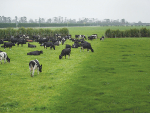China Dairy Corporation Ltd, an industry leader there, will list on the Australian Stock Exchange.
The company, whose value would be A$150 million if the share offer was fully taken up, produces -- with partners -- 600 tonnes of milk daily from 40,000 cows.
It is located in Heilongjiang province, northern China, known for dairying and other farming. It produces and wholesales raw milk and breeds, rears and sells dairy cows.
For ten years it has "built a reputation as a dependable milk supplier to major Chinese dairy product companies," the company says. Its after-tax profit in 2015 will be A$40m, it holds cash of A$70m and has low debt.
It seeks to capitalise on the growing Chinese appetite for dairy products, forecast by the OECD to grow 38% from 2013 to 2022.
"This growth has strong fundamental drivers including the rapid urbanisation of China's population as well as government policies which have included China's dairy sector as a key priority area in the Chinese government's 12th five year plan," the company says.
The chairman, Enjia Liu, says the ASX listing will be a "key milestone in China Dairy's history which will herald a new phase of growth for our company as we capitalise on increasing demand".
"We are seeing a voracious appetite for dairy products, spurred by China's rapidly urbanising population which already consumes US$5b of imported milk products annually.
"As more Chinese realise the nutritional benefits of dairy products, the potential for Australian-sourced fresh milk, butter, cheese and other dairy products to become part of the Chinese consumer's daily diet is immense."
He said Australia's dairy industry has an enviable reputation globally.
"We are keen to work with Australian dairy processors to meet that gap in China.
"With China's domestic milk production being projected to grow only at 3.3% annually between 2011 and 2020, we believe domestic milk producers will benefit from incorporating Australian technology and techniques in our production capabilities."
The company sees opportunities to grow via offshore expansion and using Australian technology to improve its farming and technology. Within China it wants to diversify into downstream growth markets such as liquid milk.


















